Akira Toriyama’s F1 Battleman Manga Explained!
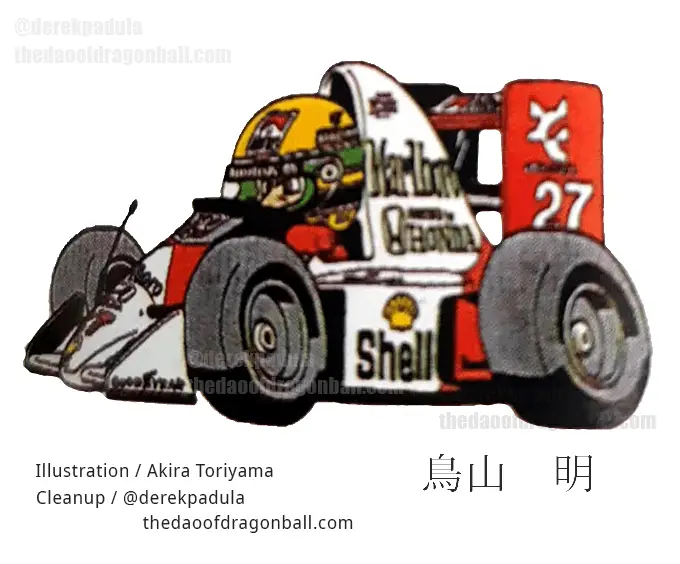
Akira Toriyama’s drawing of Formula 1 racer Ayrton Senna
Akira Toriyama’s long-lost Formula 1 manga has been translated and published by me! Now take your understanding to the next level!!
Experience the world’s first translation of Akira Toriyama’s long-lost Battleman F1 GP manga!
You can read Akira Toriyama’s Formula 1 manga here.
As I say on my YouTube channel, “Knowledge is power, and it’s time to increase your power level!”
Origin of Battleman
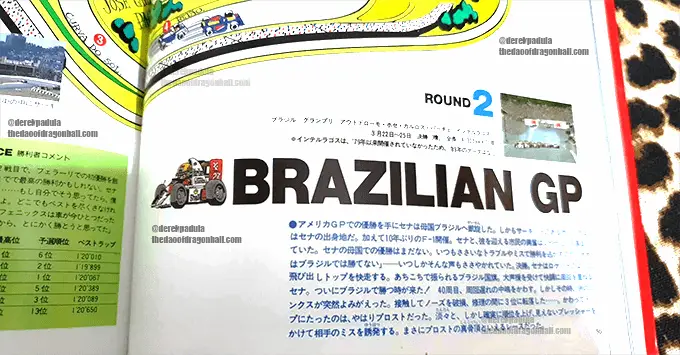
Additional pages in the Grand Prix book that focus on each circuit in the 1990 Grand Prix tournament. This one focused on the Brazilian GP.
Akira Toriyama’s F-1 Battleman GP Sports Report is a never-before-seen Akira Toriyama manga. It has never been translated officially or by fans, and it has never been published outside of Japan. Until now, by me!
I reveal the full details of its origin and source of inspiration in my article about how Akira Toriyama was inspired by Formula 1 racing legend Ayrton Senna. But I’ll give you the short version here.
Battleman was created in Japan in 1990 as part of a collaboration between Akira Toriyama, Shūeisha publishing, Honda Motors, racing team McLaren Automotive, and the Formula 1 administration.
As part of Shūeisha’s sponsorship deal with the Mclaren – Honda racing team, Akira Toriyama flew to Hockenheim, Germany to watch the team compete in a Formula 1 race.
In particular, to watch Ayrton Senna, their most successful racer and a living legend, compete, and hopefully, win the race.
Akira Toriyama shook Ayrton Senna’s hand in a photo-op, watched the race with joy, and then returned to Japan.
After Toriyama returned home, he created the Battleman manga.
Toriyama intended to be a journalist sports report of the exciting events. Except he presents the entire manga through the voice of ‘Battleman,’ a superhero-esque character obsessed with Formula 1.
Most Dragon Ball and Akira Toriyama fans don’t even know that Battleman exists. But I found a copy thanks to Kami Sama Explorer, who purchased this rare content from Japan and sent me the pages.
I invested several hundred hours to teach myself Japanese, translate the manga from Japanese to English, color correct and clean the pages, typeset the translation into the original speech bubbles, and publish it on my site.
So now, 30 years after its original publication, for the first time in history, Battleman is available to a global audience!
Please share Toriyama’s Formula 1 manga with everyone you can.
Explanations of Each Page
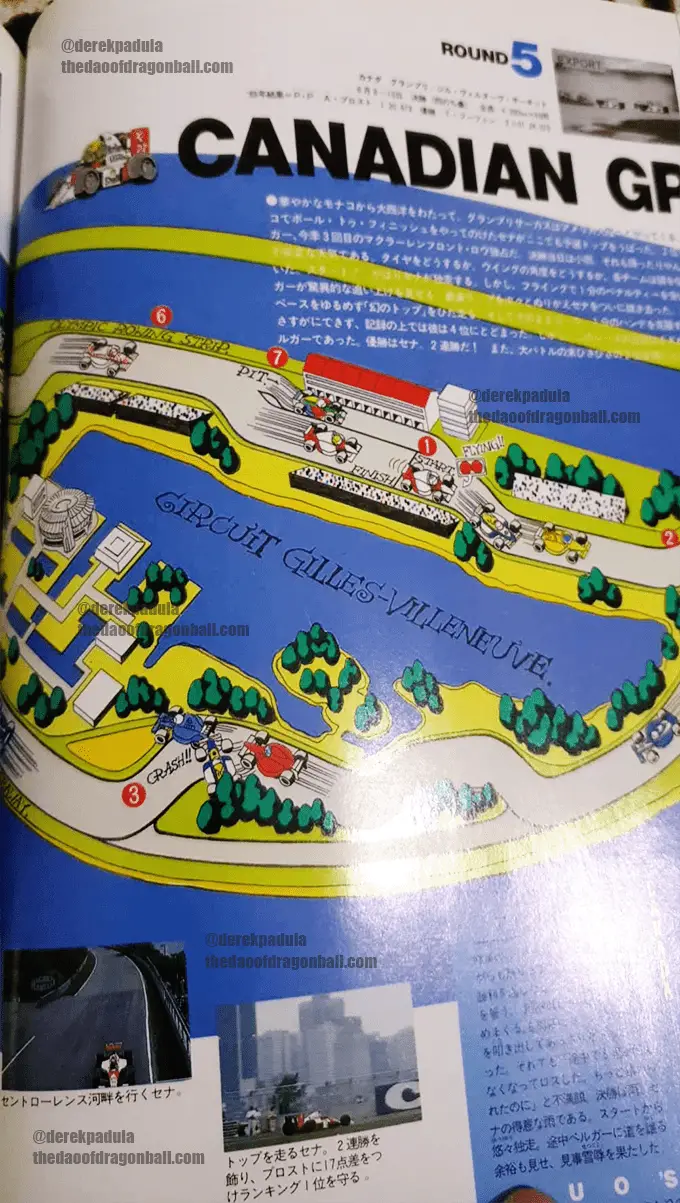
Canadian GP Round 5 of the 1990 Grand Prix
Akira Toriyama’s Battleman is written for an audience of young Japanese boys, but it’s also written for himself and other Formula 1 fans of the late 1980s and early ’90s.
Toriyama makes now-obscure references to people that were involved in Formula 1 at the time of publication, 30 years ago.
So if you don’t know the people, places, and things that Toriyama refers to in the manga, you may not be able to appreciate the reference.
Much like my Dragon Ball Culture books, this article will dive deep into every panel of every page of the Battleman manga to enrich your appreciation of Toriyama’s work.
Small samples of the manga pages are included here as reference, but the full pages are available in the Manga section of my site for a closer look.
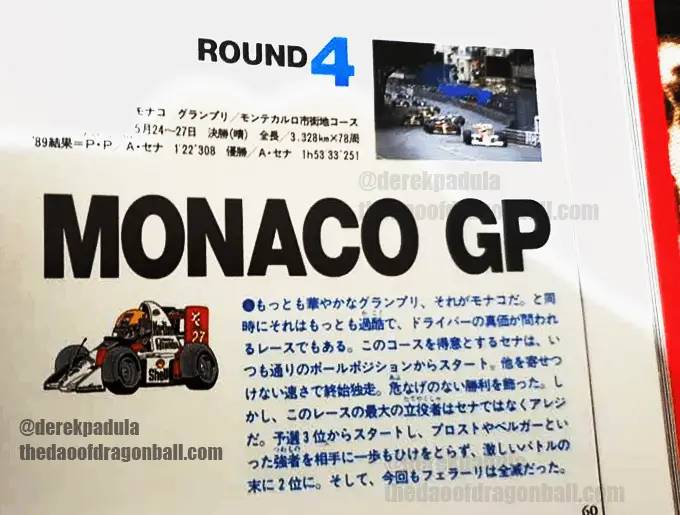
Monaco GP info in the 1990 Grand Prix
This entire Formula 1 project took me two months of effort alongside my other projects.
Yet I give this original research away for free because I love Akira Toriyama’s work and I love the Dragon Ball community, including you!
So if you see this content somewhere else, please set people straight, let them know where this research came from, and send people here.
Enjoy Akira Toriyama’s F1 manga!
Cover Page
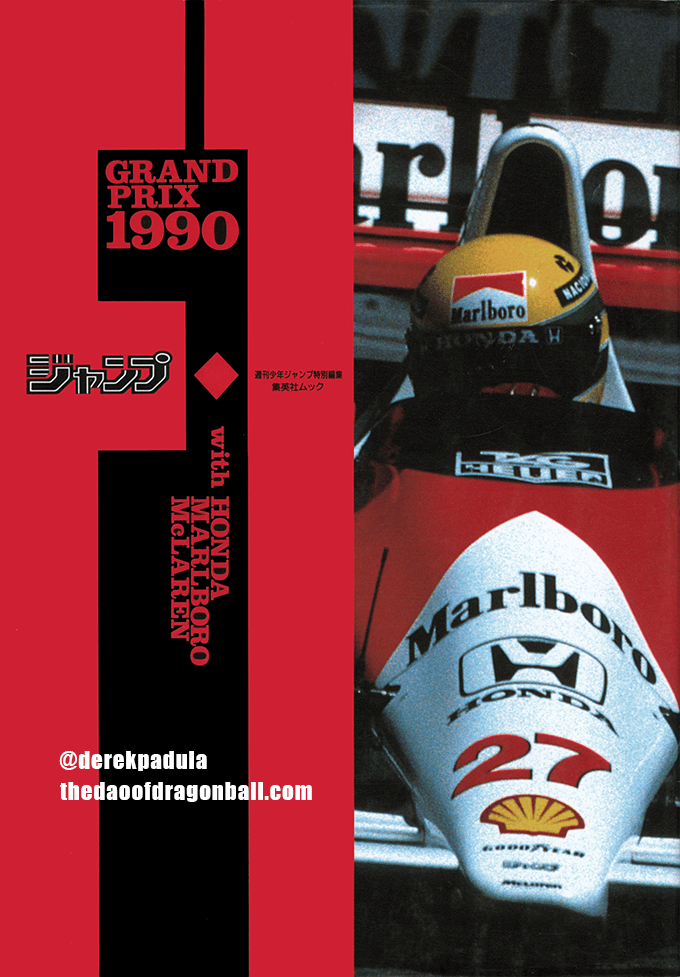
Battleman is first published in Weekly Shōnen Jump #44, in 1990. It is then republished by Shūeisha as this standalone booklet on January 10, 1991, called JUMP F-1 GRAND PRIX (ジャンプ F-1 グランプリ).
The cover page to Battleman consists of a large photograph of Ayrton Senna driving his McLaren MP4/5 in a race in 1990, driving as the number 27.
The sponsors of Ayrton Senna’s team are written on the car. It starts with Marlboro, the cigarette company, on the tail-fin. Then TAG HEUER on the windshield. Then on the nose there’s Marlboro again, Honda Motors, Shell Oil, Goodyear tires, Shōnen Jump (by Shūeisha), and McLaren Automotive.
The Japanese on the left says, “JUMP,” as in, Shōnen Jump.
The Japanese on the right says that it is a publication of Weekly Shōnen Jump, and that it is a Shūeisha ‘mook.’
Mook (ムック) is a Japanese word for a magazine-like book. It’s not a full book, and it’s not a magazine, but somewhere in-between.
Title Page
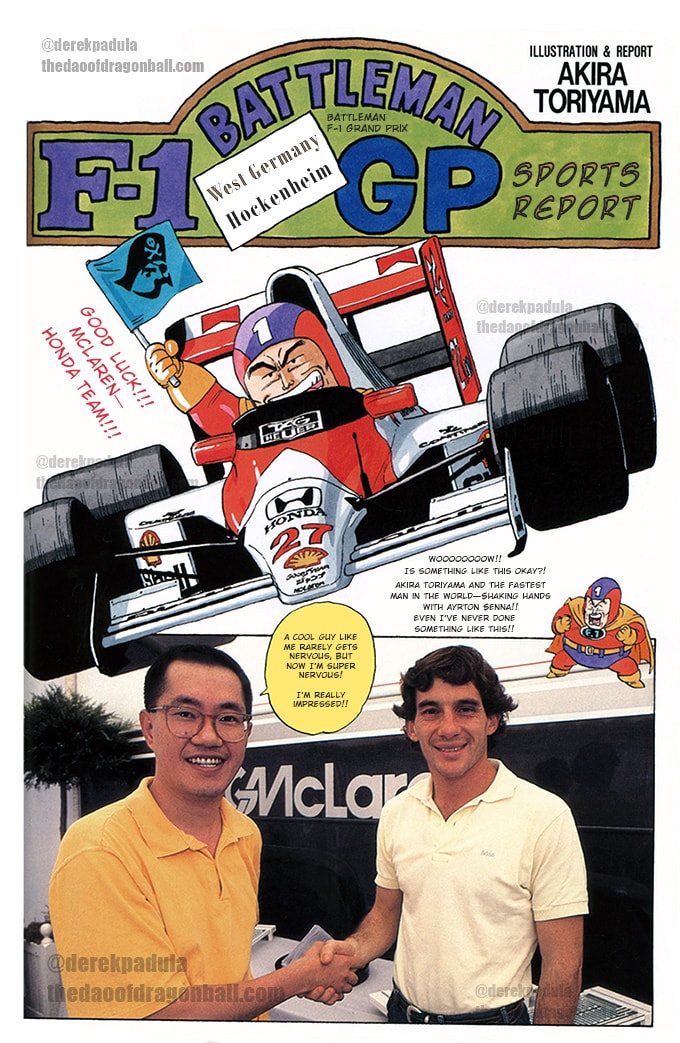
Panel 1)
The name of this character driving the racecar is Battleman, and it is one word instead of two, as ‘battle’ and ‘man.’
This is one of Toriyama’s naming conventions, as seen in Dragon Ball characters such as Dorakyuraman (ドラキュラマン, “Dracula Man”) and Gurēto Saiyaman (グレートサイヤマン, “Great Saiyaman”).
In the original Japanese version Toriyama writes Battleman’s name in English first, and then below this in small katakana text he writes the Japanese equivalent as Batoruman (バトルマン).
Toriyama does this same thing with the title of Dragon Ball, where it appears in large English letters and then small Japanese letters beneath it.
Kansenki (観戦記, “sports report,” “watching game,” or “account of a sports game”) is a word is used for any type of aftermath discussion about a sporting event or competition. It is similar to the Italian ‘reportage,’ which refers to a type of article in which direct first-hand testimony and live impressions by the reporter are provided alongside photographs.
Toriyama models his report after similar accounts of sporting events, but does it in his playful Toriyama style.
Panel 2)
Battleman drives a Honda-McLaren-powered Formula 1 MP4/5 race car. It is sponsored by TAG HEUER, Honda Motor Corporation, Shell Oil, Goodyear tires, Shūeisha’s Shōnen Jump, Marlboro cigarettes, and McLaren Automotive.
This is the same car driven by Ayrton Senna, the principle real-life driver in this manga.
Battleman is waving a flag that has the logo of Weekly Shōnen Jump on it.
The logo is a pirate’s face. This symbolizes the founding magazine editor’s desires to be a giant ship that courageously carries many different people and their dreams forward into the unknown.
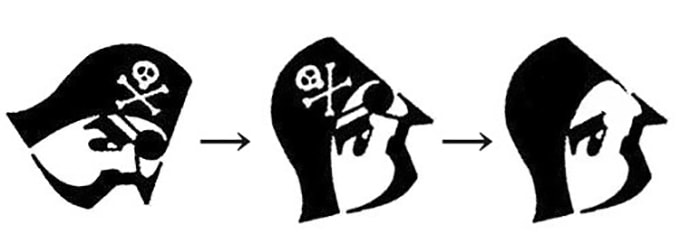
The logo of Weekly Shōnen Jump is a pirate face, but when rotated it’s a girl’s face!
Battleman is Akira Toriyama’s alter-ego in this manga.
Toriyama is the one who writes, illustrates, and takes photographs for this manga. So when Battleman is speaking, it’s actually Toriyama speaking. And this is the case even when Battleman is speaking about Toriyama. Thus, when Battleman mocks Toriyama, it’s Toriyama mocking himself.
Toriyama is shaking hands with Ayrton Senna, and you can tell Toriyama is impressed because he actually says so.
The fact that Toriyama has a fear of being seen by people and doesn’t like photographs, yet left his home, flew all the way to Germany, and allowed himself to be photographed so many times over the course of several days tells you how important this trip was for Toriyama. He wanted to meet Ayrton Senna for more than just business.
For Toriyama it was meaningful.
Page 2
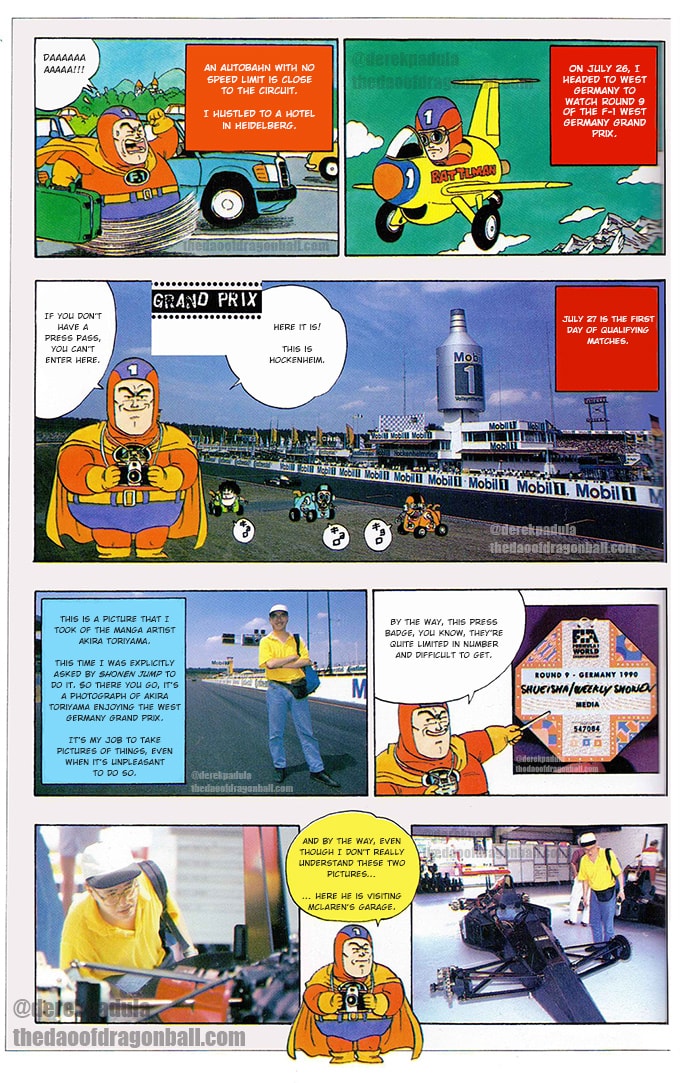
Panel 1)
“BATTLMAN” is an incorrect spelling of this character’s name of Battleman, with a missing ‘e.’
Oddly, Toriyama just spelled Battleman’s name correctly on the title page. Perhaps Toriyama drew this illustration before the title page? Perhaps he ran out of space in the illustration? Hard to know. Toriyama enjoys using English in his manga, but he is not fluent in the language, and typos like this are common for him to make.
This open-cockpit jet with fixed landing gear does not exist in real-life. I want to say it’s based on a US Air Force fighter jet, but I can’t pinpoint which one Toriyama used as a model.
Panel 2)
Toriyama writes Autobahn in Japanese incorrectly. It should be autobān (アウトバーン), but he writes it as autoban (アウトバン) without the extended ‘bā’ (バー) sound.
Toriyama writes Heidelberg in Japanese incorrectly. It should be Haideruberuku (ハイデルベルク), but he writes it as Haideruberugu (ハイデルベルグ), with a gu (グ) sound instead of ku (ク) sound. Of course, one would think that it should be gu given that the name of Heidelberg ends in a hard ‘g.’ An easy mistake to make.
Heidelberg is a city in southwestern Germany, in Baden-Württemberg, and its university is the oldest in Germany.
It’s unclear to me which cars are being driven on the road behind Battleman, but I suspect they are most likely German automobiles circa 1990s.
Can you identify them? IF so, leave a comment below.
Toriyama draws a castle in the background of this panel, behind the trees beyond the road.
This is most likely intended to be Heidelberg Castle, the most famous icon and tourist spot of the city. This castle has large towers and conical roofs just like the ones Toriyama draws.
Battleman’s suitcase belies his otherwise superhero-like costume. Perhaps he’s not actually so super. Then again, he is running on the freeway at the same speed as the cars.
Panel 3)
A giant Mobil 1 oil jug sits atop the Hockenheimring building.
The plastering of “Mobil 1” signage makes it clear they are a sponsor of this Formula One Grand Prix at Hockenheim.
The Hockenheimring circuit is empty of all-but-one car at the time Toriyama takes this picture. Given the blank slate, Toriyama adds his own cars to the track. Except in this case each car is an anthropomorphic rendering and caricature of one of Toriyama’s real-life acquaintances.
The orange car is a currently unknown person, with a black racing stripe across the center of his helmet.
The blue car is Toriyama’s personal likeness, the Tori-bot, whose true name is Robo Toriyama, as I detailed in my post on the subject, Tori-bot’s Real Name Discovered.
The green car is Mashirito, the evil genius scientist in Toriyama’s Dr. Slump manga who is modeled and named after Toriyama’s own editor, Kazuhiko Torishima.
Each of them makes the noise, kyoro (キョロ). This is the Japanese sound effect made when a person looks around restlessly, unsure of what to do next. It’s as if they don’t really belong here.
However, each of them has a racing rondel on the front of their body with a unique number on it, which implies they are part of the race.
Battleman wears a special badge around his neck, hanging down on his chest, behind his camera.
His mention of a shuzai-yō no pasu (取材用のパス, “press pass”) suggests that Toriyama received a press badge and was thus given special access to walk onto the Hockenheim circuit raceway track.
A press pass or coverage badge allows reporters to have special access to events in order to provide publicity of the event. In this case it suggests that Toriyama received the badge as part of his visit to Hockenheim to explicitly cover this event on behalf of Shūeisha as a reporter, as Shūeisha sponsored Ayrton Senna’s car, and Toriyama was thus sent to report on his big race.
Battleman is holding a professional film camera, circa 1980 – 1990. The exact model is beyond my knowledge at this time.
Panel 4)
Sign:
“FIA Formula 1 World Championship.”
FIA is the acronym for the Fédération Internationale de l’Automobile.
This is the international governing body of the Formula 1 motorsport. They represents the interests of motor organizations and enthusiasts and oversees Formula One events.
“Round 9 – Germany 1990.” Hockenheim was host to the 9th race of the 16 races held in 1990.
“Shūeisha/Weekly Shōnen.” Shūeisha is the publisher of Dragon Ball, and Shōnen Jump is the magazine in which it is published. Note that the names are westernized as they do not contain the macron over the ‘u’ and ‘o.’ It was standard practice at the time to not include them.
“Media”. Shūeisha are sponsors of McLaren and Honda and are considered “media” at this event, so Toriyama is given a press badge.
“547084.” It’s unclear what this means. Perhaps an internal number assigned to Shūeisha by the FIA staff.
On each corner of the cross it reads, “Paddock,” “Control,” “Track,” and “Pit Lane.” Presumably this means that Shūeisha and Toriyama had full access to each of these areas.
Paddock refers to a special area of the race environment with high-class food and amenities that was only accessible to the rich. This policy was changed in 2017 to allow everyday folk to access the paddock for a price.
I’m not sure what Control refers to. If you know, please tell me in the comments.
Track is self-explanatory as the race track.
Pit Lane refers to a car lane that is adjacent to a racetrack where competing teams have their garages. Cars drive into the pit lane in order to be refueled, repaired, and have tires replaced.
Battleman:
Toriyama uses Battleman’s voice to boast about how he received an official press badge as a member of Shūeisha and Weekly Shōnen Jump. Isn’t he cool!
Panel 5)
Akira Toriyama stands on the circuit track of Hockenheim. This is a rare photo of Toriyama, from 1990.
Toriyama is wearing a white hat, yellow shirt, blue backpack, black fanny pack, blue jeans, and black tennis shoes.
Toriyama writes this manga report, including the words that mock Toriyama, as a form of self-deprecating humor.
This is part of Toriyama’s style. He leaves it to the reader to figure out that it is the Battleman character who is narrating the manga.
In reality, it’s likely that somebody else who accompanied Toriyama on this trip took these pictures, but let’s imagine it was Battleman.
Panels 6 and 7)
Akira Toriyama is seen visiting the McLaren garage. He examines the chassis of a vehicle.
Toriyama’s ability to look at something with his artistic eye and then render it in his own style is uncanny. He uses it with great success in Dragon Ball.
It’s from this experience that Toriyama is later able to draw Battleman in the McLaren car on the title page of this manga.
Toriyama also draws his own versions of McLaren and Ayrton Senna’s F1 car for publication on the cover of Shōnen Jump, being driven by none other than Son Goku.
Page 3
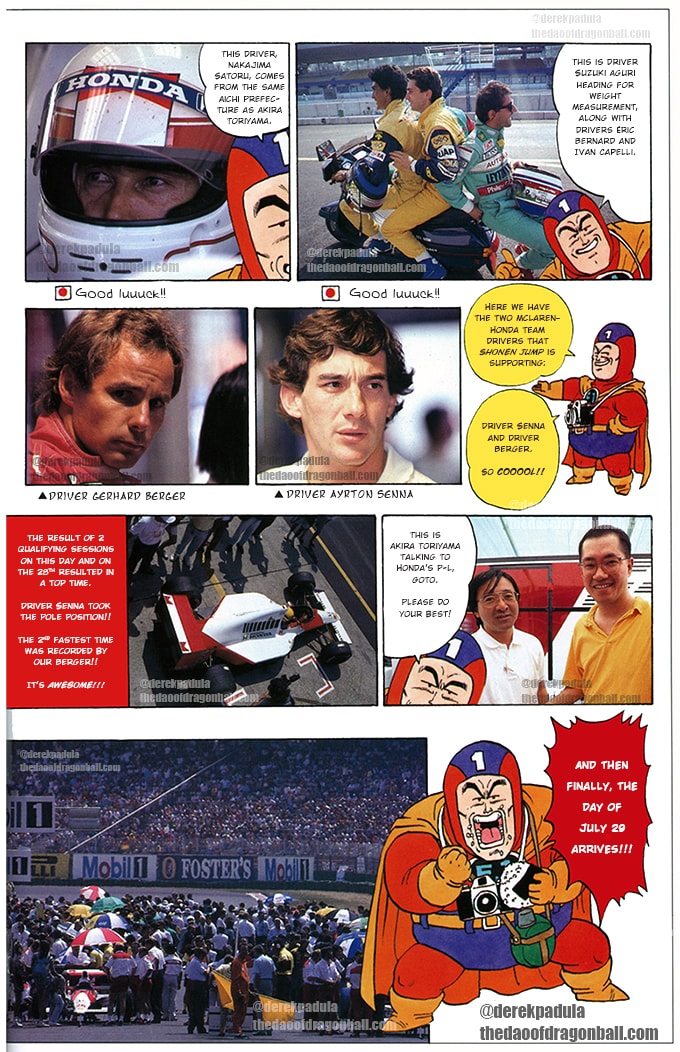
Panel 1)
Suzuki Aguri (鈴木亜久里) is a former Japanese racing driver, active from 1988 – 1995.
Suzuki’s best finish is when he placed 3rd at the 1990 Japanese Grand Prix. He then went on to manage several racing teams.
In Hockenheim, 1990, he raced under team Espo Larrousse F1 in a Lola LC90, and he retired (did not finish).
Éric Bernard (Japanese: エリック・ベリナール) is a former French racing driver, active from 1989 – 1994.
Bernard’s best finish is third place at the German Grand Prix in 1994.
In Hockenheim, 1990, he raced under team Espo Larrousse F1 in a Lola LC90, and he retired (did not finish).
Notice that Bernard and Aguri have the same uniforms.
Ivan Capelli (イーバン・カペリ) is a former Italian racing driver, active from 1985 – 1993.
Capelli achieved three podium positions and scored a total of 31 championship points. In Hockenheim, 1990, he raced under team Leyton House in a Leyton House CG901, and he earned 7th place.
Panel 2)
Translation: “This driver, Nakajima Satoru, comes from the same Aichi Prefecture as Akira Toriyama.”
Nakajima Satoru (の中嶋悟選手) is a former Japanese racing driver, active from 1987 – 1991.
In Hockenheim, 1990, he raced under team Tyrrell Racing Organisation in a Tyrrell 019, and he retired (did not finish).
Nakajima’s helmet was iconic for being white with two red lines around it that form a circular end on the chin area. This is what is photographed here. A Japanese audience would recognize Nakajima from just seeing his helmet and eyes.
Nakajima and Toriyama are both natives of the rural Aichi Prefecture.
Nakajima was born in Okazaki (岡崎市), while Toriyama was born in Nagoya (名古屋市).
So Toriyama is speaking through Battleman in order to point out that both of them are farmer boys, and Nakajima has made it big and is living the dream.
It can be inferred that Toriyama relates to Nakajima. Perhaps Toriyama thinks of him as a success.
Panel 3)
Ayrton Senna (アイルトン・セナ) was a former Brazilian racing driver, active from 1984 – 1994.
Senna won the Formula One World Drivers’ Championship in 1988, 1990, and 1991. He is considered by many F-1 experts to be one of the greatest drivers of all time.
In Hockenheim, 1990, he raced under team Honda – Marlboro – McLaren in a McLaren MP4/5B, and he earned 1st place.
In 1994, he died in a car crash while leading the 1994 San Marino Grand Prix, when he hit the concrete retaining wall at 300 kilometers per hour (186 mph) and severed his brainstem.
The crash was caused by multiple factors, including car handling failures, personal stress, family problems, and recent deaths of friends. His funeral in Brazil was treated by the government and the people as a national day of mourning.
Gerhard Berger (ゲルハルト・ベルガー) is a former Austrian racing driver, active from 1984 – 1997.
Berger won ten Grand Prix, achieved 48 podiums, 12 pole positions, and 21 fastest laps.
In Hockenheim, 1990, he raced under team Honda – Marlboro – McLaren in a McLaren MP4/5B, and he earned 3rd place.
Berger had a long and storied history with his teammate Senna, working together as friends, but often appearing to be rivals in the same race.
Panel 4)
Akira Toriyama is shaking hands with the Project Leader of the Honda Team. Through Battleman, Toriyama is wishing the leader well.
P・L, Purojekutōdā (プロジェクトーダー, “Project Leader”) is a Japanese abbreviation for a foreign term, of a PL. So in this case, he is the Honda Project Leader.
Gotō Osamu (後藤治) is a racing car engineer who served as Honda’s F-1 project leader.
Gotō is one of the developers of the engine that led Ayrton Senna to win the race at Hockenheim, in 1990.
He also worked with Alain Prost, Gerhard Berger, and Michael Schumacher—all of whom are considered the greatest drivers of all time.
Gotō became famous in Japanese F1 fandom when Fuji TV’s televised run of the F1 relay gave him the nickname “Honda’s Fighting Chief.”
Gotō’s reign as project leader is considered a golden era for Honda.
Panel 5)
Pole Position is a term used in racing to refer to the most favorable position at the start of a race, placed on the inside of the front row of competitors.
It is given to the driver with the best qualifying times in the days before the race.
Pictured here is the McLaren MP4/5B sitting in the pole position in front of the starting line.
Ayrton Senna earned the pole position due to his qualifying times, while Gerhard Berger earned second. Both are on the McLaren team, powered by Honda and sponsored by Shūeisha.
Panel 6)
A packed audience at Hockenheim, with the racers and their crew standing on the track.
Ayrton Senna, #28, sits in the pole position.
Page 4
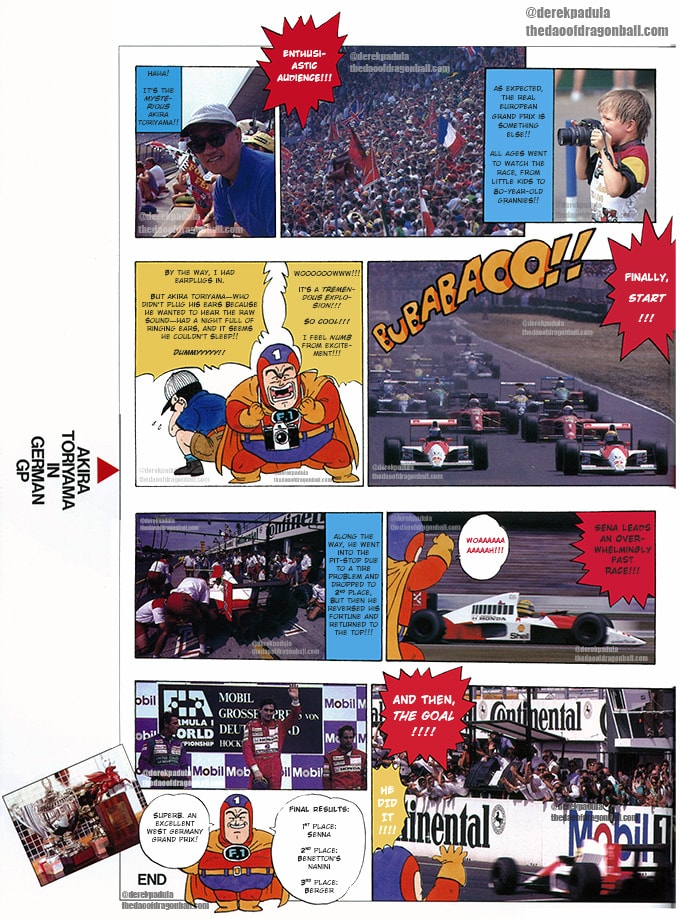
Panel 1)
Pictured is a boy holding a camera and wearing a Formula 1 racing shirt.
Panel 2)
Flags from many nations are being waved in the crowd. Can you name them all?
Panel 3)
Akira Toriyama is famous for being afraid of fame. He usually hides behind a surgical mask and avoids the public. To see him in the middle of a crowd of people like this is unprecedented.
Also: Stylin’ shades.
Panel 4)
The two Honda McLaren’s lead the pack, driven by Senna and Berger, as #27 and #28.
“BUBABAOO!!” is a Toriyama-style sound effect for the roaring engines of the F1 cars approaching you.
Even though he is Japanese and writes for a Japanese audience, Toriyama writes many of his sound effects in Roman letters.
In fact, this trait of Toriyama’s is what got him noticed by his editor at Shūeisha and started his entire career. So without sound effects like this, Akira Toriyama the world famous manga author would not exist.
Panels 5 – 8)
No notes
Panel 9)
Benetton’s Nanini (ベネトンのナニーニ) refers to the international racing team Benetton Formula Ltd. and their driver Alessandro Nannini.
Alessandro “Sandro” Nannini (アレッサンドロ・ナニーニ) is a former Italian racing driver, active from 1986 – 1990.
Nannini achieved a single winning race, 9 places on the podium, and scored a total of 65 championship points.
In Hockenheim, 1990, he raced under team Benetton Formula Ltd. in a Benetton B190, and he earned 2nd place.
However, Nannini’s career ended later that year when his right forearm was severed in a helicopter crash.
The original text of “Medetashi medetashi (めでたし, めでたし)” is a Japanese expression that refers to a situation where everything works out in the end, in an excellent, superb, and pleasing manner.
Pictured are the three racers on the podium, with Senna raising his hand toward the crowd.
Pictured are the trophies of the Formula 1 winners.
Concluding Thoughts
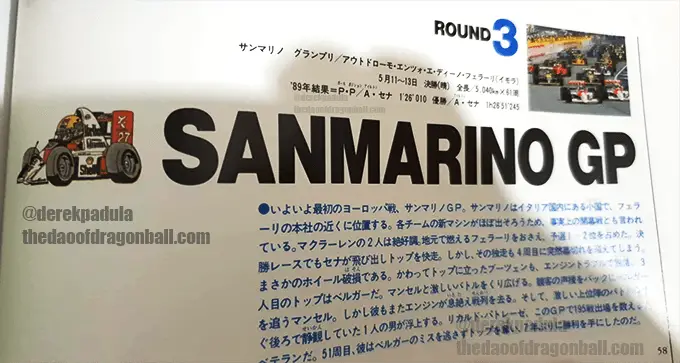
San Marino GP of the 1990 Grand Prix
This was a momentous occasion. All the stars aligned.
A living Brazilian legend and living Japanese legend. An exciting period of time where Ayrton Senna and Akira Toriyama were in their prime.
Toriyama was a fan of Senna’s, and of F1, and then he goes to Germany to capitalize on Shūeisha’s sponsorship, and that’s the day when Ayrton wins.
It was a brief moment in time and, as it turns out, the only time these two superstars would have together.
Shūeisha picked the right horse! Or horses, in this case, as both Senna and Berger won the day.
Four years later, Ayrton Senna would die in a car crash during a race.
Fans of Senna’s across the world mourned the loss, but especially in Brazil.
No one knows how Akira Toriyama felt about the loss.
But thanks to his report, now we know how he felt during their time together.
If there’s a lesson here, it’s that time is short and we don’t know when our lives will end.
So follow your passion, live your life to the limit, and share your gifts with the world while you can.
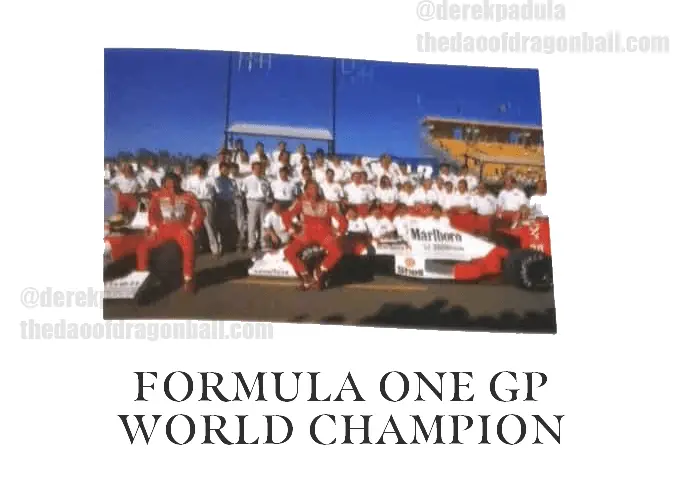
The 1990 World Champion Honda – Mclaren team
I hope you enjoyed learning more about Akira Toriyama’s Formula 1 manga!
Did you learn anything new?
Want to see more in-depth research and long articles like this one that uncover lost Akira Toriyama history and lore?
Write something in the comments!
' . $comment->comment_content . '
'; } } else { echo 'No comments found.'; }